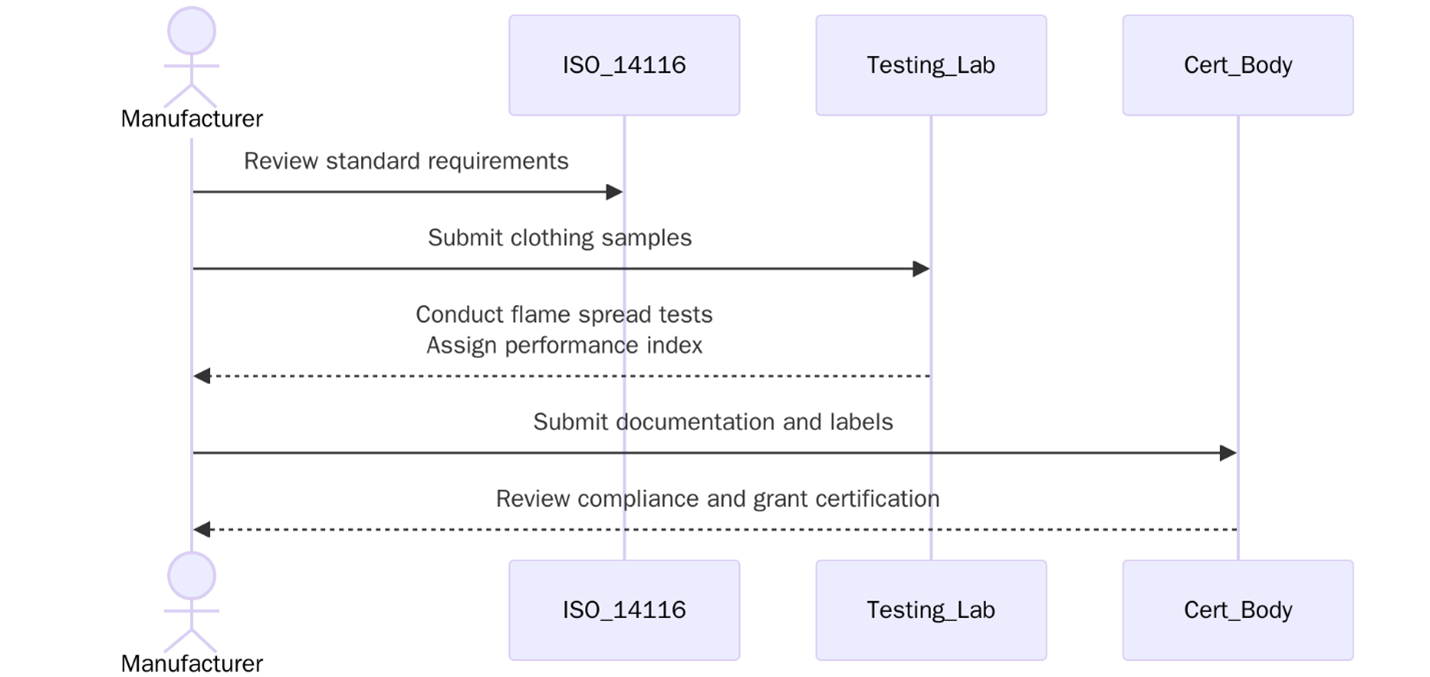What is ISO 14116:2015?

ISO 14116 specifies performance requirements for the limited flame spread properties of protective clothing materials. This standard is intended for protective garments that minimize the possibility of the clothing igniting and continuing to burn when exposed to brief contact with small flames. It is mainly applied where risks of exposure to flame exist but where low-level protection is appropriate. Unlike fully flame-retardant gear, this standard applies to garments that still must be worn in less extreme work conditions involving incidental flame hazards.
Industries like oil refineries to automotive and manufacturing rely on ISO 14116-compliant clothing for workers operating near flammable materials or ignition sources. It allows organizations to offer a defined level of safety while keeping garments lightweight, breathable and suited for daily use.
To begin your ISO 14116 certification process or to speak with our audit team, reach out at support@pacificcert.com
What is the purpose of ISO 14116?
The main aim of ISO 14116 is to minimize the risk of clothing igniting when subjected to brief flame exposure. This standard supports workplace safety by evaluating and classifying materials based on their flame spread behavior. While it doesn’t replace standards for full flame protection, ISO 14116 provides manufacturers and employers a useful framework when choosing or designing workwear for tasks involving minor flame hazards.

By focusing on limited flame spread instead of full fire resistance, it addresses the balance between basic protection and garment comfort. It also helps prevent misleading safety claims in garments sold as flame-retardant.
Scope and Applicability
ISO 14116 applies to all protective clothing where limited flame spread properties are required. The standard includes both the materials and the clothing assemblies, including seams, zippers, and labels. It covers:
- One or more layers of clothing, either outer or underlayers
- Non-permanent flame protection (e.g., treated cotton)
- Apparel used in industrial sectors like petroleum refining, utilities, and gas fitting
- Protective wear for technicians and maintenance workers
This standard does not apply to garments that offer protection against intense heat, molten metal splash, or electrical arc, which are covered by other standards such as ISO 11612 or ISO 11611.
Clause-wise Structure of ISO 14116:2015
Clause | Title | Description |
1 | Scope | Defines where and how this standard is to be applied |
2 | Normative References | Lists relevant standards for cross-comparison |
3 | Terms and Definitions | Clarifies terms such as flame spread, index levels, and testing procedures |
4 | Performance Requirements | Provides the flame spread index levels and testing tolerances |
5 | Test Methods | Specifies procedures for determining limited flame spread |
6 | Marking and Labelling | Describes required labels for compliance and user warnings |
7 | Information to be Supplied | Outlines details that must be made available to users and auditors |
What are the requirements of ISO 14116:2015 Certification?
Before seeking certification under ISO 14116, manufacturers must ensure that the protective clothing materials meet specific requirements related to flame spread behavior. These requirements are tested under strict lab conditions. Below are the key requirements:

- Materials must undergo flame spread testing using ISO 15025, Procedure A or B.
- Garments are categorized into index levels 1, 2, or 3 based on flame spread performance.
- Clothing labeled with index 1 must not be worn directly against the skin and must be layered with higher protection garments.
- Materials must be pre-treated and conditioned as per the standard before testing.
- The number of washes before the test must be declared since performance may degrade.
- Labels must clearly indicate the flame spread index and care instructions.
- All components of the garment (e.g., buttons, thread, reflective strips) must also comply with the same level of performance.
What are the benefits of ISO 14116:2015 Certification?
Gaining ISO 14116 certification offers significant benefits to clothing manufacturers and employers in industrial settings. Below are the key benefits:

- Verifies flame-retardant claims using internationally accepted methods
- Reduces risk of minor burns in industries handling flammable materials
- Builds buyer and end-user confidence in protective apparel
- Helps companies meet buyer specifications in oil, gas, and maintenance sectors
- Encourages safer product design in lightweight and breathable materials
- Supports conformance with national health and safety rules in multiple countries
- Makes supply chains more reliable with certified garments for hazard zones
The demand for ISO 14116-certified garments has increased across industries like oil and gas, utilities, and industrial maintenance, especially in regions with strict safety expectations. Companies are shifting toward lightweight, flame-resistant materials that meet basic safety standards without compromising comfort for daily wear.
What are the Eligibility Criteria?
Any organization involved in the manufacturing, distribution, or design of flame-resistant clothing can apply for ISO 14116 certification. There are no restrictions based on company size or location. However, garments submitted must be finished products or fabric assemblies meant for real-world application. Accessories, footwear, or non-textile PPE are not within this scope.
Manufacturers must also declare the number of washing cycles after which flame resistance holds, as this impacts eligibility and labeling.
Certification Process of ISO 14116
Pacific Certifications follows a step-by-step approach to ensure proper validation and testing of clothing materials under ISO 14116. The process typically involves:
- Identify product lines and materials needing flame protection certification.
- Prepare samples of garments and components for flame spread testing.
- Submit to accredited labs for ISO 15025 testing as specified in ISO 14116.
- Collect and verify test results and flame spread index data.
- Stage 1 audit – Review of technical documentation and garment construction.
- Stage 2 audit – Optional manufacturing site audit to inspect ongoing production quality.
- Final evaluation and certification issued for compliant garments.
Timeline for ISO 14116:2015 Certification
Typically, the process from initial testing to certification completion takes about four to six weeks. This timeline depends on the number of garments submitted, fabric types involved, and lab test turnaround. If garments require pre-treatment or conditioning prior to testing, the timeline may extend by one or two more weeks.
What is the cost for ISO 14116:2015 Certification?
The cost of ISO 14116 certification varies based on garment types, quantity of fabric samples, and the range of index levels requested. Testing multiple garment variations (e.g., different fabric blends or stitch styles) may require separate analysis, which increases the overall cost. Discounts may be available for bundled testing or combined audits with ISO 11612 or ISO 9001.
How can Pacific Certifications Help?
Pacific Certifications offers full-service ISO 14116 certification, helping clients in flame-prone sectors meet buyer and safety expectations. Our services cover:
- Sample selection and documentation preparation
- Lab testing coordination and guidance
- Review of flame spread index ratings and UPF levels (if required)
- Pre-certification checks of labelling and wash care instructions
- Batch verification and optional site audits
- Integration with ISO 9001 quality audits for textile manufacturing
Training and Courses
We also offer industry-relevant training programs aligned with ISO 14116 for quality teams and product developers:
Lead Auditor Training: Designed for professionals conducting internal reviews of flame-retardant garments and factory records.
Lead Implementer Training: Suitable for material engineers and designers integrating ISO 14116 into product development and compliance files.
Internal Auditor Training: Focused on in-house quality teams and supervisors responsible for flame protection assurance.
Pacific Certifications provides accredited training programs. If your organization is looking for ISO 14116 training, our team is equipped to help you. Contact us at support@pacificcert.com
FAQs
Is ISO 14116 mandatory for all flame-retardant garments?
No, but if a manufacturer wants to declare limited flame spread performance, ISO 14116 is the standard for classification and labeling.
What does an index level mean?
Index levels 1 to 3 indicate how a material performs under flame contact. Level 3 offers the highest limited flame spread resistance.
Can ISO 14116 be used together with ISO 11612?
Yes, many manufacturers get both certifications depending on the garment use-case. ISO 11612 covers heat and flame resistance more extensively.
How many times can ISO 14116 certified clothing be washed?
It depends on the material. The number of cycles is tested and must be declared on the label.
Are all fabrics eligible for ISO 14116 testing?
Only fabrics that can undergo ISO 15025 testing and meet the required index levels are considered eligible.
Do reflective tapes and accessories need to comply too?
Yes, all components, including trims and closures, must meet the same flame spread performance for the index claimed.
What hazards does ISO 14116 actually cover—and what doesn’t it cover?
ISO 14116 is about limited flame spread—brief contact with small flames. It is not intended for sustained heat, welding sparks, or firefighting; for those risks, look to standards like ISO 11612 (heat/flame), ISO 11611 (welding), or EN 469 (firefighting).
How is limited flame spread tested under ISO 14116?
The standard references ISO 15025 (Procedures A & B): a test flame is applied (typically 10 seconds) and afterflame/afterglow, hole formation, and edge flaming are assessed to assign Index 1–3.
Ready to get ISO 14116:2015 certified?
Contact Pacific Certifications to begin your certification journey today!
Suggested Certifications –
Read more: Pacific Blogs






